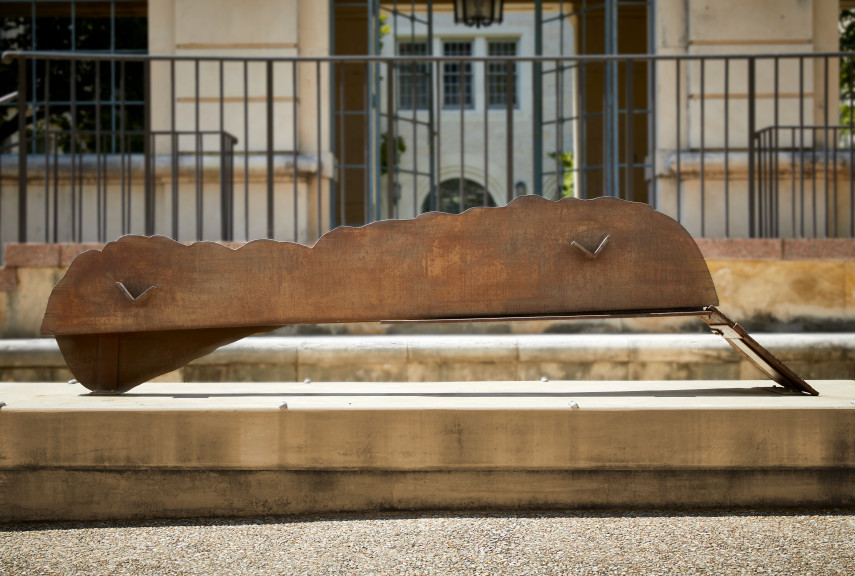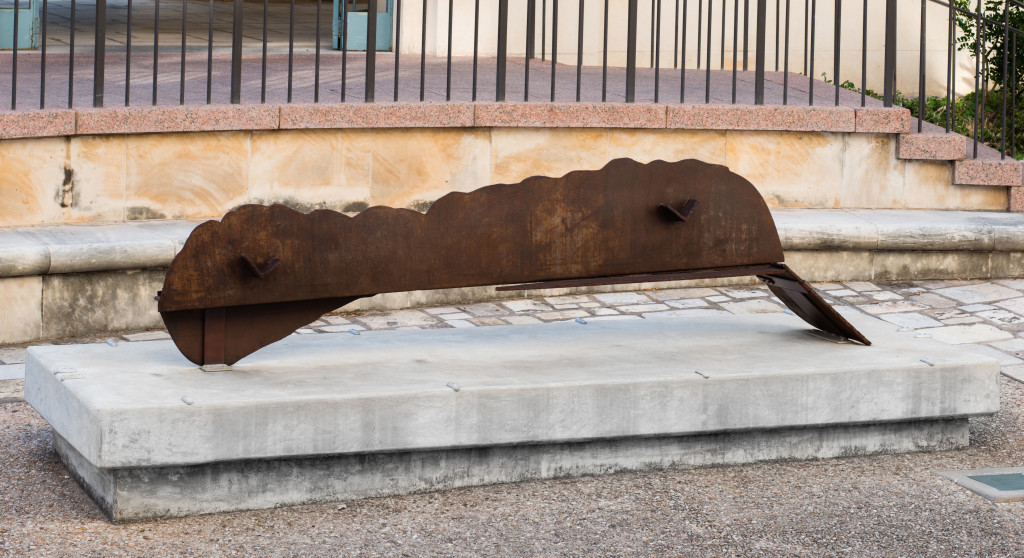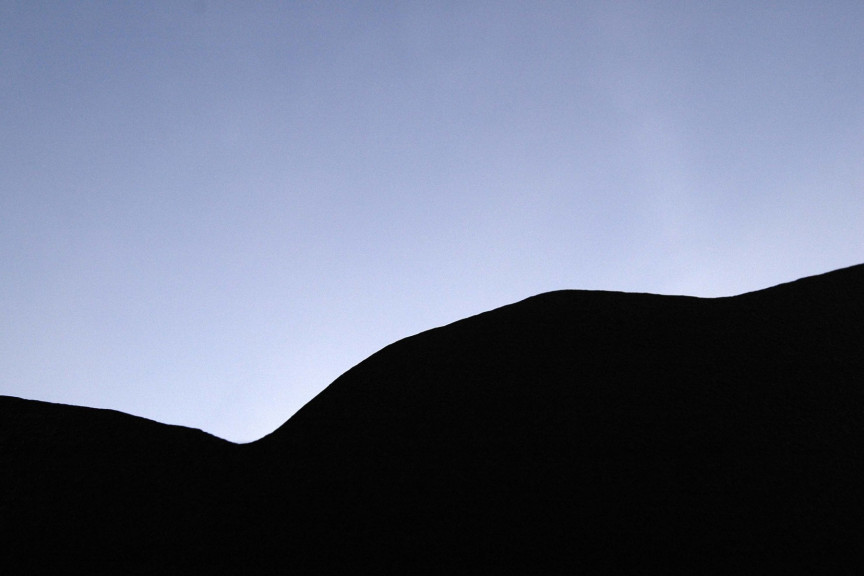Veduggio Glimpse
Anthony Caro
30 × 113-1/2 × 18 inches
Photography not permitted
Lent by The Metropolitan Museum of Art Anonymous Gift, 1986
1986.440
GPS: 30.285453,-97.740814
Before being drafted into the British Navy during World War II, Anthony Caro studied engineering at Cambridge University. After the war he enrolled at the Royal Academy in London to study sculpture. Caro went on to work as a studio assistant to Henry Moore (1898–1986), who was then the most important and renowned sculptor in Great Britain. During this period of apprenticeship, Caro made works that, like Moore’s, abstracted the human figure.
Caro’s first extended visit to the United States in 1959 prompted a radical new direction in his work. He met the modernist art critic Clement Greenberg (1909–1994) and several notable abstract artists, particularly the sculptor David Smith (1906–1965). Upon his return to London, Caro created his first abstract sculptures, developing a new three-dimensional language in works of welded steel that spread laterally, low to the ground. He composed his works intuitively, without preliminary drawings or models. To unify the different sizes and shapes of the various pieces of metal, Caro painted the finished work in a single color.
During the 1970s, however, Caro found himself becoming “too comfortable” with color. He stopped using paint to focus on the composition of forms in space, and he began using wood and clay in addition to steel. In November 1972, and again in May and November 1973, he worked at the Rigamonte factory in Veduggio, Italy. Caro experienced a burst of creative activity, assembling fourteen sculptures in ten days. The steel remnants he found in the factory’s scrapyard were unlike anything he had worked with before. “They all had this sort of soft edge,” he explained, “all curved ends and all sorts of rust.” Though resolutely abstract, Veduggio Glimpse alludes to a landscape tableau. With its arcing silhouette, and rusty, weathered surface, it is among the most painterly of Caro’s Italian sculptures.
ACTIVITY GUIDES
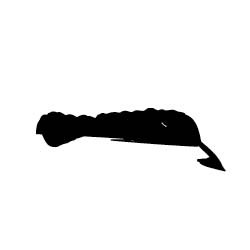
Veduggio Glimpse
Anthony Caro
Subject: Vertical and horizontal
Activity: Make a sculpture that works when vertical and horizontal
Materials: Cardboard, construction paper, scissors, and glue
Vocabulary: Vertical, horizontal, sculpture
When a line or object is vertical, it stands tall from top to bottom, like a tree or flagpole. When something is horizontal, it takes up the most space from side to side. Vertical and horizontal are opposites. Most sculptures stand straight up and down, like people do, and may be seen at or above eye-level. This sculpture is different from most because it is wide across and sits close to the ground, below us instead of at eye-level or above us.
This sculpture is named after a city in Italy, Veduggio. Do you think this sculpture looks like a place?
If we turn our heads and look at this sculpture sideways, we can imagine how it would look vertically, standing on its end. Would this sculpture look like anything if it stood up vertically?
Using a pencil, have your child draw a simple shape on cardboard or construction paper. It can be a shape that is familiar, or something that is made up. Turn the page and have your child look at the shape both vertically and horizontally, pointing out its differences. Next, ask your child to draw shapes that look like something both vertically and horizontally. For example, if we turn an arrow so that it points up, vertically, it can look like a tree.
Horizontal —Positioned across, from side to side, the same the horizon, and the opposite of vertical
Vertical —Positioned upright, like a flagpole, and the opposite of horizontal
Sculpture —A work of art that has height, width, and depth
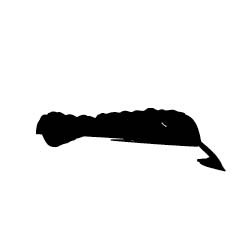
Veduggio Glimpse
Anthony Caro
Subject: Abstract Expressionism
Activity: Create an Abstract Expressionist painting
Materials: Paper and paint
Vocabulary: Abstract expressionism, geometric abstraction, representational, non-representational
Anthony Caro is a British artist working in an Abstract Expressionist style. He is inspired by his materials and by his own feelings and ideas, and he often works spontaneously. Many of his sculptures, like _Veduggio Glimpse_, are created without any preliminary drawing or sketches.
Caro named this sculpture after the city Veduggio, Italy where he created it as part of a series. According to the artist, this sculpture does not depict an actual landscape. Rather, it is an abstract expression of his surroundings. Caro strives to make sculptures about real experiences without making exact representations of them. In spite of this, to many people this sculpture looks like a landscape, which is art that depicts scenery or a setting, like the city or the country.
How do titles of artworks influence our thoughts about them? Might titles of abstract works give us hints about their meaning?
Why would an artist give their artwork a title that is contradictory?
If this work were untitled, would it give a different meaning to the work?
What kind of freedom does expressing ideas in abstract forms give to artists?
Using paint on paper, create a painting using abstract forms that represent your feelings about a particular idea or subject. While you are painting, keep a specific thought in mind and freely express your emotions associated with that idea. Experiment by using different colors and brushstrokes to represent the different ways your subject makes you feel, without depicting it in realistic form.
After it is complete, allow it to dry and then look at it from various angles and think about what you see.
Abstract Expressionism -- 1940s New York painting movement based on using abstract imagery to express emotions and experiences
Geometric Abstraction -- a style of art that uses geometric shapes to create a composition that is not representational or realistic
Representational -- depicting people, places and things as they appear or are seen
Nonrepresentational -- not depicting any recognizable object or thing
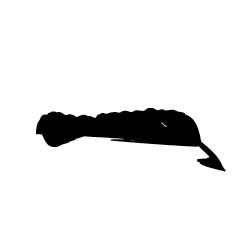
Veduggio Glimpse
Anthony Caro
Subject: Landscape
Activity: Draw or paint an abstract landscape
Materials: Paper and paint or colored pencils
Vocabulary: Landscape, abstract, depict, representational
Anthony Caro named this sculpture after the city in which he made it, Veduggio, Italy; however, he insists that the sculpture does not depict anything realistically. Even though the work is called _Veduggio Glimpse_, it is not actually an image of Veduggio. Caro’s experiences and feelings as well as the metal he works with inspire him. In his artwork he strives to make sculptures about those experiences and materials without making representations of them. In spite of this, to many people this sculpture looks like a landscape, or art that depicts scenery or a setting, like the city or the country.
If this does not look like a landscape, what does it look like?
Does art always have to depict something?
Can art be about nothing at all?
If you did not know the title of this sculpture, what would you think it depicted?
Think of a landscape you know well. Maybe it is the view outside from your bedroom window, or somewhere you ride past in the car or on the bus everyday. It can be in the city or country. Make a quick sketch of the landscape on paper. Using paints or colored pencils, make an abstracted version of this landscape. Draw shapes and lines but don’t worry about your art being representational or accurate. Use shapes and colors that represent how you feel about the place, rather than how the place looks.
Abstract —Expressing a quality apart from the way an object appears to the eye; the opposite of realistic
Depict —To represent with a picture
Landscape —A wide view of scenery
Representational —Depicting people, places, and things as they appear or are seen
MORE INFORMATION
Son of a stockbroker turned gentleman farmer in England, Anthony Caro attended a boarding school from 1937 to 1942. There he was introduced to the sculptor Charles Wheeler, who invited the boy to help in his studio during school holidays. Thus Caro learned the techniques of making metal armatures to support plaster and clay compositions.
Caro studied engineering at Cambridge University from 1942 to 1944 but was then conscripted into the air service of the British Navy. Like many young men demobilized after World War II, Caro was determined to pursue his own interests. Instead of returning to university, he studied sculptural techniques under various teachers at the Royal Academy in London from 1946 to 1952. He also worked as a studio assistant to Henry Moore, who was then the most important and renowned sculptor in Great Britain.
In the late 1950s, Caro sculpted in a figural mode, but his first extended visit to the U.S. in 1959 prompted a radically new direction. He met the powerful modernist critic Clement Greenberg and several notable abstract artists, particularly the sculptor David Smith. Upon his return to London, Caro created his first welded steel works.
From 1953 to 1979, Caro taught at the St. Martin’s School in London, where he mentored future sculptors Barry Flanagan, Richard Long, Tim Scott, William Tucker, and Bill Woodrow. In the summers 1963–65, he also taught at Bennington College, Vermont, which was a center for formalist art theory and practice; among his studio assistants there were the abstract sculptors Willard Boepple and James Wolfe.
Caro’s best sculptures from the 1960s and 1970s are open-form structures extending in several directions and incorporating a lot of empty space. His abstract constructions had no base and no center, resulting in a sense of airiness rather than massiveness. Often he experimented with the horizontal relationship of sculpture to ground.
Inspired by works he had seen in America, Caro painted his first steel sculptures; he considered color an essential component in his art. He preferred a single color for each sculpture rather than several hues. In the 1970s, Caro decided that he had become “too comfortable” with color and stopped using it in order to focus more strongly on the composition of forms and space. Thereafter he preferred raw steel, which he allowed to weather naturally outdoors for a few months. After the original factory coating (“mill scale”) had deteriorated and flaked off, the surface acquired a warm orange-brown patina. Then the sculpture was lightly sanded and coated with a clear oil to protect against harsh weather (if left unprotected for long, the steel would corrode irreparably).
Veduggio Glimpse, 1972–73
Despite the weight and unwieldiness of industrially produced steel, Caro composed his sculptures spontaneously, without preliminary drawings or models. He was interested in the process of discovery. In this sense, his sculptures are sometimes considered the three-dimensional equivalents of the gestural vitality of Jackson Pollock’s “action painting” and the improvisational pouring of paint onto unprimed canvas by Morris Louis. Caro used sheets of steel as if they were sheets of paper: cutting, tearing, and folding them like three-dimensional collages on a large scale.
In November 1972, and again in May and November 1973, Caro worked at the Rigamonte factory in Veduggio, Italy, with James Wolfe as his assistant. The result was fourteen sculptures assembled from steel remnants in the factory’s scrapyard (as David Smith had famously done at another factory in Volta, Italy, in 1959). Four of the Veduggio series were shown at the André Emmerich Gallery in March 1974. Despite the titular reference to the place where it was made, Veduggio Glimpse is a purely abstract work intended to be appreciated entirely for its visual qualities.
Valerie Fletcher is Senior Curator at the Hirshhorn Museum in Washington, DC. Her research on groundbreaking aspects of international, globalized, and transnational art have resulted in numerous exhibitions and publications.
Barker, Ian. Anthony Caro: Quest for the New Sculpture. Burlington, VT: Lund Humphries, 2004.
Blume, Dieter, ed. Anthony Caro: Catalogue Raisonné. Cologne: Galerie Wentzel, 1981–2007. Texts by Lawrence Alloway, Dieter Blume, Michael Fried, Peter Fuller, Tim Hilton, and Peter Murray.
Bryant, Julius. Anthony Caro: A Life in Sculpture. New York: Merrell, 2004.
Fried, Michael. “Two Sculptures by Anthony Caro.” Artforum 6 (February 1968): 24–25.
Greenberg, Clement. “Anthony Caro.” Arts Yearbook 8: Contemporary Sculpture (1965): 106–9.
Haufschild, Lutz. “Conversations with Anthony Caro.” artmagazine (June 1978): 30–35.
Moorhouse, Paul, ed. Anthony Caro. London: Tate Publishing, 2005. Texts by Michael Fried, Dave Hickey, and Paul Moorhouse.
Rubin, William. Anthony Caro. New York: Museum of Modern Art, 1975.
Tuchman, Phyllis. “An Interview with Anthony Caro.” Artforum 10 (June 1972): 56–58.
Waldman, Diane. Anthony Caro. New York: Abbeville Press, 1982.
The Metropolitan Museum of Art in New York generously loaned twenty-eight modern and contemporary sculptures to Landmarks for display throughout the Austin campus. The collection represents a broad array of artists working in the second half of the twentieth century. The initial sculptures were installed throughout the main campus in September 2008, and a second, smaller group were unveiled at the renovated Bass Concert Hall in January 2009.
Funding for the loan was provided by the Office of the President. This project was the result of a collaborative effort among many, including:
Leadership
Andrée Bober and Landmarks
Pat Clubb and University Operations
Douglas Dempster and the College of Fine Arts
Landmarks Advisory Committee
William Powers and the Office of the President
David Rea and the Office of Campus Planning
Bill Throop and Project Management and Construction Services
Gary Tinterow and the Metropolitan Museum of Art
Samuel Wilson and the Faculty Building Advisory Committee
Project Team
Chuck Agro, transportation, Metropolitan Museum of Art
Andrée Bober, curator and director, Landmarks
Caitlin Corrigan, registrar, Metropolitan Museum of Art
Cynthia Iavarone, collections manager, Metropolitan Museum of Art
Cliff Koeninger, architect
Ricardo Puemape, Project Management and Construction Services
Kendra Roth, conservator, Metropolitan Museum of Art
Patrick Sheehy, installation services
Nicole Vlado, project manager, Landmarks
Special Thanks
Valerie Fletcher, curatorial contributor
Beth Palazzolo, administrative coordination, University Operations
Russell Pinkston, composer
What’s Past Is Prologue: Inaugurating Landmarks with the Metropolitan Sculptures
With the arrival of twenty-eight modern sculptures on long-term loan from New York’s Metropolitan Museum of Art, the Landmarks program has begun. Their installation throughout the Austin campus offers a remarkable opportunity to survey some of the major trends in art during the second half of the twentieth century. These sculptures allow us to witness the distinctly modern dialogue between representation and abstraction, as well as the contest between natural and industrial materials. Most of all, we can celebrate their presence as an unprecedented chance to experience works of art first-hand––to appreciate their forms and to understand the underlying ideas.
The Landmarks program perpetuates in Austin one of civilization’s oldest and most enduring traditions: the placing of art in public areas, accessible to nearly everyone and expressive of collectively held ideas. More than five thousand years ago, the cultures of Egypt and Mesopotamia produced sculptures for urban plazas, government buildings, and places of worship to express political, secular, and religious values. Grand monuments endorsed the ruling elite and commemorated military victories, while images of deities symbolized spiritual beliefs. The original purposes of public art were primarily ideological and didactic, but what has endured through the ages is the physical beauty of the art. In modern times the contexts and goals for public art have changed considerably. In many parts of the world democracy and egalitarianism have supplanted absolute rulers, and explicit religious power has yielded to secular humanism. During the mid-to-late twentieth century (the era when the Metropolitan’s sculptures were created), globalization has redefined the entire world. Societies in Europe and the Americas have became so diverse that cultural authorities can no longer be sure of which systems of meaning and which values, let alone which individuals, should be honored in the traditional ways of public art.
A schism has developed between traditionalists and modernists. In a rapidly changing world those who wanted to preserve the familiar in art have continued to commission representational statues. Modernists, on the other hand, have embraced change and gladly jettisoned the old ways in favor of abstraction. The schism is exemplified by two famous memorials in Washington, D.C., both intended to commemorate the heroic sacrifices of American armed forces. The Marine Corps Memorial (1954) consists of a superbly realistic representation of soldiers struggling to raise the American flag on Iwo Jima in 1945. In contrast, the Vietnam Memorial (1982) consists of a massive V-shaped wedge of polished black stone inscribed with What’s Past Is Prologue: Inaugurating Landmarks with the Metropolitan Sculptures July 2008 the names of the dead. At the time it was inaugurated, this monument shocked nearly everyone outside the art world and outraged many of those it intended to commemorate. In response, a group of bronze figures of soldiers was added. But soon, precisely because of its universal form and absence of imagery, the original memorial became a powerful place where all Americans could go to grieve, remember, and pay homage. To most of the art world, this demonstrated beyond a doubt the viability of abstract sculpture for public places.
With America’s increasing wealth and social consciousness in the 1960s many towns began to institute programs of commissioning sculptures for public places. By requiring that 1 or 2 percent of each building’s construction budget be used for art, urban planners sought to improve the living and working environment for millions of people. The main difficulty was agreeing on what kind of art was visually pleasing and, just as important, potentially meaningful to the general public. Two highly publicized examples were the huge, abstract, metal sculptures by Pablo Picasso and Alexander Calder, in Chicago and Grand Rapids respectively, which at first provoked derision but gradually became a source of community identity and pride.
One way to approach works of art is to consider the historical context in which they were created. During the first half of the twentieth century, life and art underwent radical transformations. Industrial manufacturing supplanted agriculture as the dominant mode of production, people migrated from rural areas to urban centers, women and minorities gained equal rights, warfare expanded to an unprecedented global scale, and technology accelerated the pace of life—and art changed in tandem.
Abstraction
Early in the modern era, many artists believed that a new visual language was needed to replace the Greco-Roman classical figurative traditions that had persisted through two millennia. Photography had made mimesis (accurate depiction of reality) unnecessary in painting and sculpture for the first time in history. Artists were free to conceive radically new approaches, and so abstraction was born, emerging from 1910 to 1920 in Europe. Initially artists simplified and stylized observed reality into organic and angular forms. That first phase soon evolved into making “pure” abstractions with no recognizable sources. From the outset, abstract art carried implicit meanings recognized by artists and informed viewers but largely lost on the general public.
Early abstractionists intended their art to convey their commitment to an ongoing transformation of society. Like Morse code in telegraphy and other new modes of communication fundamentally different from the traditional written word, abstract forms in art could convey meanings—not narrative or literal ones but broad ideas that could speak to an international audience and help advance human consciousness.
During the 1920s and 1930s, artists developed two broad types of abstraction: geometric and biomorphic. Geometry denotes mathematics and suggests such related disciplines as architecture, design, engineering, and logic as well as intangible qualities like analytical thinking and precision—desirable attributes for a rational, communal society. Artists devised a new language of geometry in art: horizontal and vertical elements can convey calm, harmony, and stability (see Harmonious Triad by Beverly Pepper), while rising diagonals can suggest energy and optimism (see Column of Peace by Antoine Pevsner and Square Tilt by Joel Perlman).
In contrast to geometric abstraction, a number of artists favored softer forms and curving contours. Inspired by sources in nature, biomorphic abstractions evoke natural phenomena, biological processes, growth, and ambiguity (see Big Indian Mountain by Raoul Hague, Source by Hans Hokanson, and Untitled [Seven Mountains] by Ursula von Rydingsvard). Such works stand in general opposition to the industrial and technological aspects of modern life; they remind us of the fundamental importance of the natural world. Biomorphism was invented and advocated by the surrealists, who believed in the importance of the unconscious mind in creating and understanding modern art. Relying on the Freudian concept of free association, such artists expect viewers to generate their own unique responses to abstract art.
The two types of abstraction began as competing and opposing philosophies, but by the 1950s many artists expertly combined them to suit their expressive needs (see the rhythmic contours of Veduggio Glimpse by Anthony Caro and the disconcerting, hulking forms of Catacombs and Guardian by Seymour Lipton).
By the 1960s, the original philosophical meanings underlying abstraction had mostly faded away, leaving “formalist” aesthetics: the creation and appreciation of pure nonreferential beauty. Formalism dominated much artistic practice from the 1950s through the 1970s, particularly in the United States in the circle around the critic Clement Greenberg. Geometric sculptures became ubiquitous in public places—some complex and sophisticated and some merely competent. A group known as the minimalists advocated an intellectually rigorous, austerely reductivist approach (see Amaryllis by Tony Smith). Other artists went in the opposite direction, toward complexity and a decorative verve (see Kingfish by Peter Reginato). From those extremes emerged the postminimalists, who infused organic vitality into simple, singular forms (see Curve and Shadow No. 2 by Juan Hamilton).
Figuration
Despite the enthusiasm for abstraction in midcentury, a number of artists insisted on maintaining recognizable human content in their works. Abstraction had alienated many viewers who found it remote or incomprehensible. Yet few artists returned to traditional realism, preferring instead to explore new and evocative modes of representation.
The strongest resurgence occurred in the aftermath of World War II. Many artists, especially in Europe, wanted to pay homage to the sufferings experienced by so many people during the war and to their struggles to rebuild their lives and societies amidst the new fears engendered by the nuclear age and the Cold War. This atmosphere of postwar existential anxiety was poignantly expressed in two museum exhibitions in the 1950s: models for a never-realized Monument to the Unknown Political Prisoner at London’s Tate Gallery in 1953 and the avowedly humanist theme of the New Images of Man installation at New York’s Museum of Modern Art in 1959.
Many postwar sculptors expressed their angst by portraying figures or fragments of bodies as falling, broken, injured, or partially robotic (see Augustus by Bernard Meadows and Figure by Eduardo Paolozzi). Some erudite artists reinterpreted classical myths, particularly those in which a hero challenged the gods and were punished: Icarus, Hephaestus, Prometheus, Sisyphus (see works by Koren der Harootian and Frederick Kiesler). Seymour Lipton created a particularly effective amalgam of figure references within abstract forms that harbor dark inner spaces (see Pioneer, Catacombs, and Guardian).
Representational sculpture was submerged by the tidal wave of abstraction in the 1960s and 1970s, but a new generation insisted on a legible humanist content in art, addressing issues of personal identity and isolation in an impersonal world (see Eyes by Louise Bourgeois and Figure on a Trunk by Magdalena Abakanowicz).
Materials and Methods
Modern sculptors also introduced a new language of materials and methods. In the late nineteenth century, sculpture making had entered a new phase of mass production made possible through technology: bronzes could be produced in large editions by skilled technicians from an artist’s original. The Thinker by Auguste Rodin, for example, was made in several editions, ranging from a dozen life-size bronzes to hundreds of smaller casts. This mechanization and concomitant commodification of art prompted a reaction. Appearing simultaneously in several countries, the “direct carve” movement advocated older craft-based methods and sought to enhance the intrinsic characteristics of natural materials: the color and grain of exotic woods or the veining and crystalline structure of unusual stones. By the 1920s, this aesthetic had gained international prominence, and it persists to this day.
The first generation of direct carvers admired prehistoric, African, Oceanic, and indigenous American artifacts. By adapting the hieratic frontality and stylized forms of those sources to the sleekly refined forms of abstraction, modern sculptors could represent simplified figures linked in sophisticated linear rhythms (see works by Koren der Harootian and Anita Weschler). Recent artists of this orientation tend to work on a larger scale and may roughly cut and hew wood to achieve expressionistic textures (see works by Hans Hokanson and Ursula von Rydingsvard).
Carvers remained a relatively small minority in modern sculpture, far outnumbered by “direct metal” sculptors. Their approach emerged in prewar Europe and burgeoned into an international movement in the 1950s and 1960s. Seeking materials and methods appropriate to the modern Machine Age, artists looked to engineering and construction for inspiration. Instead of using chisels to carve wood and stone, constructivists preferred welding torches to cut and join pieces of metal. Their structures ranged from elegant abstractions to assemblages of cast-off objects.
The industrial analogy and model extended to the sculptors’ own studios, which resembled factory spaces with heavy-duty equipment. Some—like Anthony Caro, Willard Boepple, and Robert Murray—found inspiration in working spontaneously and experimentally with sheet metal: cutting, folding, rolling, welding, soldering, and sometimes painting or burnishing it. Other sculptors, notably Tony Smith, were comfortable with sending models to factories for professional fabrication. Both methods were considered appropriate for a modern world that had been so fundamentally reshaped by industrial manufacture.
In contrast, many sculptors preferred to make assemblages from miscellaneous bits and pieces of scrap, sometimes irreverently called “junk sculpture.” Although artists had experimented with this approach as early as the 1910s, it became a widespread tendency only decades later in the 1950s and 1960s, when sculptors made three-dimensional collages from the detritus of industrial manufacture and mass consumption: rusty machinery, old car parts, squished used paint tubes, broken musical instruments, virtually anything. The motivations for using trash range from simple necessity (when an artist has no money to buy new materials) to antimaterialistic social criticism and environmentalism (sculptors started recycling long before the idea occurred to others).
Regardless of the motivations, a found-object sculpture possesses an inherent dual identity: its former reality as a useful thing and its new reality as art. That dualism inevitably poses an intellectual and visual conundrum for us. Do we see Deborah Butterfield’s Vermillion primarily as a lifelike depiction of a horse or as a composition of rusty, crumpled bits of metal thrown out by a wasteful consumerist society? And what are we to understand from Donald Lipski’s seemingly abstract The West, which consists of decontextualized harbor buoys and lots of corroded pennies? The artists offer clues and hope that we will use our own eyes, intellect, intuition, and imagination to make connections and create meanings.
Landmarks: Sculptures for Inquiring Minds
Unlike works in private collections or even museums, public sculptures exist in our daily environment, interact with our activities, and enter our awareness repeatedly and variously. Beyond the pleasure they bring to viewers already acquainted with art, they can stimulate curiosity and spark new perceptions in the minds of passersby who might otherwise not have much aesthetic experience. As the university’s population seeks knowledge in classes, libraries, and laboratories, the Landmark sculptures can offer other kinds of discoveries. Visitors to the Perry Castañeda-Library, the Nano Science Technology Building, the School of Law, and elsewhere on the campus can now see immediately that the visual arts have a prominent place and come away enriched. Very few campuses or cities can boast so many sculptures of such quality that are free and accessible to all. The twenty-eight sculptures from the Metropolitan Museum of Art proclaim the broad purpose of the Landmarks program: to bring an important new dimension to the life of the university, to the everyday experience of its students, faculty and staff, the citizens of Austin and beyond, and to any person who just crosses the campus.
Valerie Fletcher is Senior Curator at the Hirshhorn Museum in Washington, D.C. Her research on groundbreaking aspects of international, globalized, and transnational art have resulted in numerous exhibitions and publications.

